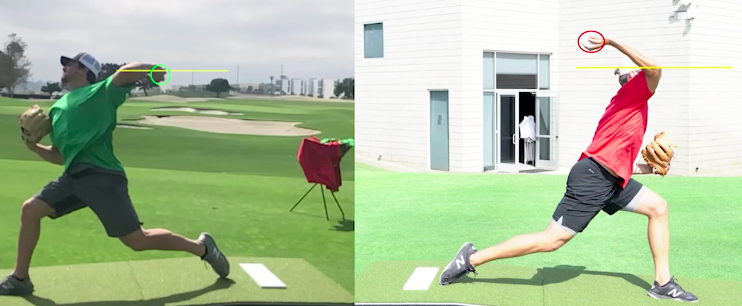Layback isn't just the product of shoulder external rotation
Fri Jan 5, 2024 by OnBaseU

One of the most important physical capabilities for a pitcher is the ability to achieve maximum shoulder external rotation (or layback) in the Cocking Phase of their delivery.
There are a number of reasons why layback is important, not the least of which is that it can help a pitcher maximize velocity. Essentially, if a pitcher wants to increase their velocity, they need to do one of two things: apply a higher average force to the ball (by increasing intent, strength or improving kinematic sequence) or apply a force over a greater distance (by increasing mobility and/or arc). We often refer to the latter as "ramp." The longer the ramp, the more time we have to generate force. The greater the layback, the longer the ramp.
If a pitcher lacks layback, we refer to it as a pitching characteristic called High Hand. High Hand is very easy to identify. Simply advance a pitcher to maximum external layback in the "face-on" view. Draw a horitzontal line that bissects their elbow joint. If the ball is above the line, the pitcher has a High Hand. Look at the pitcher in the red shirt (High Hand) vs the pitcher in the green shirt in the header above.
Though external rotation of the shoulder is a critical factor in a pitcher's ability to achieve layback, it is wrong - and dangerous - to assume that shoulder ER is the ONLY factor. Here's Dr. Rose explaining why.
One of the primary reasons we created OnBaseU was to eliminate two assumptions commonly made by coaches, S&C and medical professionals:
ASSUMPTION #1: If a pitcher has High Hand they should focus on improving shoulder ER.
WRONG. Our pitching screen includes a Shoulder 90/90 test that assesses a pitcher's shoulder ER and their ability to maintain scapular stability in an athletic posture verses a full stride posture. Performance on this screen is related to High Hand, but it isn't the sole cause of High Hand.
Like all hitting and pitching characteristics, High Hand is multifactorial. Though the cause can be physical, it is not limited to the shoulder. Often, you'll find that High Hand is a product of inefficient technique (e.g. Early Flexion, see video below) or limited range of motion elsewhere in the body (e.g. limited extension of the hip or spine). Here's an example from a recent Q&A webinar of how something like Early Flexion can cause High Hand.
One of the purposes of developing our screen is to help coach, S&C or medical professionals identify the root cause of technical inefficiencies. Before you start cranking on a pitcher's shoulder, let's check to see if shoulder ER is even the issue.
ASSUMPTION #2: If a pitcher has good layback (no High Hand) there's no need to assess their body.
WRONG. Assuming an pitcher's movement capabilities based on a single checkpoint like layback is a woefully incomplete assessment. Elite athletes are great compensators, but those compensations don't always prioritize efficiency or durability. As Mike Boyle likes to say, "the body does what is easiest, not always what is best."
Therefore, just because a pitcher has good layback doesn't mean they moving efficiently or - worse- aren't a ticking timebomb. For example, if a pitcher can't extend from their hip or spine (assessed in our Lunge with Extension Test), they can compensate by seeking more external rotation in the shoulder. This may help them achieve layback and avoid a High Hand, but it also puts excessive stress on the shoulder. Want to know what body part is most vulnerable to break down in an athlete? Identify the body part that is overworked.
Movement screens aren't intended to turn coaches into doctors, but to help them identify a problem exists. At our seminars, we analogize athlete screening to a driver being able to read the dials on a racecar. Here's Dr. Rose at Lantz Wheeler's Pitch-A-Palooza last year:
The goal of the OnBaseU screen isn’t to make coaches responsible for fixing problems with an athlete’s body, but to help them determine IF there is a problem with an athlete’s body.
— OnBaseU (@OnBaseU) May 5, 2020
From @LantzWheeler’s Pitch-A-Palooza. pic.twitter.com/ZbkdqtnS3E
If you're not screening an athlete physically, you might be missing a blinking "Check Engine" light on your athlete. If you're not assessing an athlete, you're guessing that they can physically do what you're asking them to do.